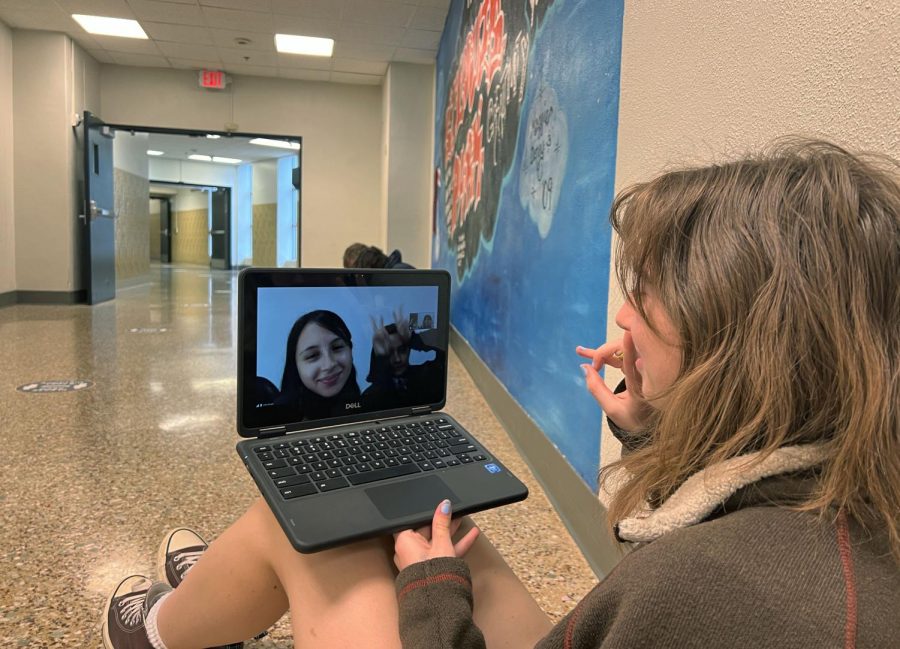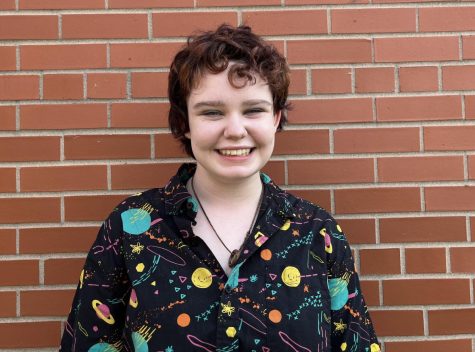Connections made across the world
Spanish class communicates with students in Columbia
Senior Nora Gardner talks with her pen pals on Zoom May 20. IB Spanish students met with students from a private school in Facatativa, Columbia.
May 25, 2022
Three Spanish classes, one advanced and two second level, have the opportunity of connecting with students across the world in Columbia for a semester-long class project.
This project started a few years ago after middle school teacher Gladis Romero Phillips recommended the project to Hanna Anderson, the Spanish teacher running the project.
Anderson said the project was something she had been thinking about for a while, but was unsure on how to start it.
“You always think as a teacher, ‘it would be so cool to connect with another teacher in another country,’ but this just came to me through Gladis Romero,” Anderson said. “She knew this teacher in Columbia, and worked with that teacher in the past, but the age difference didn’t help that much. So she recommended that I start working with the teacher in Columbia and it was just a perfect match.”
Senior Sylvia Leppik says the project makes it easier to understand what it’s like to use Spanish as your language everyday.
“It’s definitely helped me see how language is used a bit more informally. Because you know in school we are learning a very academic language whereas when you’re talking with people who are native speakers they’re using it a bit more like we would use English,” Leppik said.
Anderson said the project is a good way to improve her students’ language skills in a way they couldn’t before.
“They are motivated to use words that are an important part of communication but sometimes don’t get a chance to use them in the classroom. It comes as a more natural way of communicating,” Anderson said.
Freshman Ana Whorton said that the project made her a better student and gave her a new friend and perspective.
“(The project) definitely helped with my Spanish skills and it was fun to talk with my partner because we’re so different,” Whorton said.
Aside from the opportunity to speak with people in another country, this project also adds a special perspective because according to Anderson the school specializes in agriculture.
“The school in Columbia is not a normal school — it’s an agricultural school, a very unique school in a town on the outskirts of Bogota, Columbia,” Anderson said. “They have a very unique system for our students to learn about — how students start at 7 in the morning and are there until 5 (p.m.) because they have to take care of the pigs and the cows and the sheep and the chickens and the rabbits and the vegetable garden.”
The students participating in this project are also fans of the new viewpoint it adds to their education. Leppik says she’s interested in the agricultural aspect the Columbian school has.
“The school they go to is really interesting because it’s agricultural stuff,” Leppik said. “It specializes in agriculture so they are learning stuff that’s super interesting to me.”
Anderson said the project has allowed students to get a unique perspective on what life is in Columbia.
“I would say it’s very fascinating for them (the students),” Anderson said.
Leppik said she really enjoys learning about different people and the differences between her and them.
“Getting to know someone who lives somewhere completely different from me and has a completely different lifestyle but still finding similarities between us,” Leppik said.
Anderson said her students will most likely not stay in contact, but that the experience will stay with them forever.
“It has been interesting to see a couple of students really ask each other questions and some of them have exchanged social media information and they have been exchanging emails,” Anderson said.




